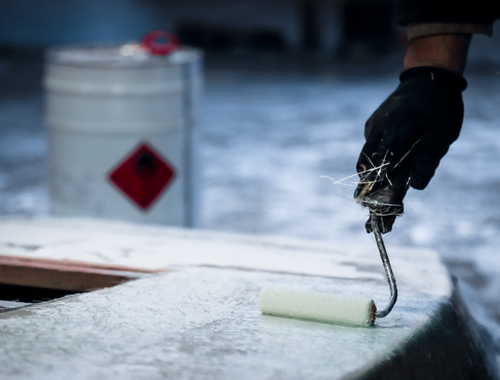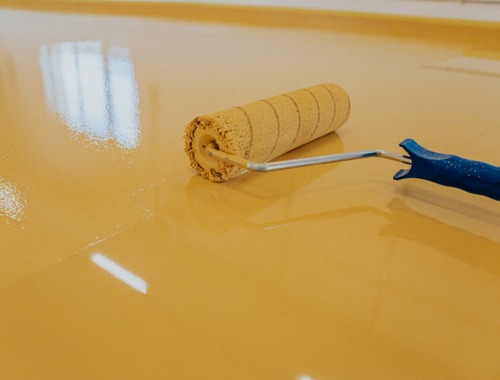Difference Between Epoxy Curing Time and Temperature
If you’re working on high-quality flooring, epoxy coatings are typically applied to resist corrosion and because it bonds seamlessly with existing surfaces, creating durable surfaces that will last for years. It is slip-resistant, shock resistant, and less abrasive, making it better than other types of industrial flooring. But epoxy resins need to be cured which basically converts the liquid ingredients into a solid state. But it is important to understand the science behind the curing process. But the whole process takes time before it reaches its ultimate strength. And this curing time varies from brand to brand. Temperature also affects the process as the epoxy cures faster in warm temperatures.

Epoxy Curing Time
Amid the many benefits of epoxy resins, there is one unavoidable fact that they aren’t very easy to work with because not all epoxy resins are created equal. When working on an epoxy project, it’s vital to understand the science behind it and the drying time. The curing time of epoxies mainly depend on the epoxy brand you’re using for a specific application. Some people would like to sand down their resin or move their pieces to some other location. So, if the epoxy is not fully cured then such actions can damage the process. Typically, you can expect your epoxy to be fully set in about 72 hours give or take. You can expedite the curing process by using additional heat outside of room temperature. If you’re using 100 percent solid epoxy, you can expect it to be ready in about 18 hours or less.

Epoxy Curing Temperature
The resin is made to sit for a few hours at room temperature. A general rule of thumb is to keep temperatures humid and warm in order to speed up the epoxy drying time. You can add a heat lamp to provide more warmth for your space so that the room sits at about 70 to 80 degrees. And look out for any bubbles on the surface when monitoring your epoxy after pouring with a heat gun or a torch. But do not apply these methods on the surface for very long as it may lead to cracks or discolorations in the surface or burnt areas. If the epoxy layer is thick, you need more heat which results in a quicker reaction. Heat speeds up the chemical reaction of epoxy components. Some resins are formulated to cure in low temperatures about 35 degrees.
Difference between Epoxy Curing Time and Temperature
Factors
– Both time and temperature are extremely vital factors that come to play when it comes to epoxy curing because they aren’t very easy to work with because not all epoxy resins are created equal. The curing time of epoxies mostly depend on the epoxy brand you’re using for a specific application. Similarly, temperature is an equally important factor that greatly affects the curing time of epoxy resins. So understanding the science behind curing is important.
Ideal Time/Temperature
– Typically, you can expect your epoxy to be fully set in about 72 hours give or take. You can expedite the curing process by using additional heat outside of room temperature. But most epoxies take around 7 days before they are fully cured. Heat speeds up the chemical reaction of epoxy components. Some resins are formulated to cure in low temperatures about 35 degrees. But the ideal temperature for an epoxy to reach its maximum potential and to cure perfectly is 65 to 80 degrees.
Epoxy Curing Time vs. Temperature: Comparison Chart

Summary
The curing time of an epoxy mostly depends on the brand of the epoxy you’re using for your project. While some solid epoxies have a curing time of no more than 48 hours, the art resin features a super fast 30 minute working time. Temperature greatly affects the epoxy curing time. So, you can expedite the curing process by using additional heat outside of room temperature. The ideal temperature for the epoxy to cure is between 65 and 80 degrees. The product itself plays a critical role in the curing time. But you can expect faster results by creating a humid environment because epoxies need heat to harden.
Does temperature affect epoxy curing?
Temperature is a vital factor that greatly affects the curing time of epoxy resins. Warmer temperature leads to faster epoxy curing times.
Does heat or cold cure epoxy faster?
Heat expedites the epoxy curing process. The ideal room temperature for epoxy curing is 60 to 80 degrees. This is the ideal temperature for the epoxy to reach its full potential.
What is the difference between set time and cure time?
The set time for an epoxy is usually 12 to 48 hours, but to achieve a full chemical cure, it needs around 7 days or less depending on the brand of the epoxy and the curing conditions.
What is the full cure time for epoxy?
Typically, most epoxies are full cured within a week. On an average, you can expect it to be usable within 72 hours. But the curing time may vary from brand to brand. When it’s fully cured, you will know for sure. At that point you cannot even put a dent on it with your thumbnail.
Does epoxy cure slower in cold?
A general rule of thumb is that epoxy cures faster in humid and warm temperature, unless specially formulated for cold-weather use. Generally heat speeds up the epoxy curing process.
What temperature does epoxy cure best at?
Epoxy reaches its highest potential when it is cured at a moderate temperature between 60 to 80 degrees. This is the perfect temperature for the epoxy to cure and bond seamlessly.
- Difference Between Caucus and Primary - June 18, 2024
- Difference Between PPO and POS - May 30, 2024
- Difference Between RFID and NFC - May 28, 2024
Search DifferenceBetween.net :
Leave a Response
References :
[0]Ellis, Bryan. Chemistry and Technology of Epoxy Resins. Berlin, Germany: Springer Science & Business Media, 2012. Print
[1]Sharma, Pooja. Epoxy Resin, Types and Their Curing Agents. California, United States: Lap Lambert Academic Publishing, 2013. Print
[2]May, Clayton. Epoxy Resins: Chemistry and Technology, Second Edition. Oxfordshire, United Kingdom: Routledge, 2018. Print
